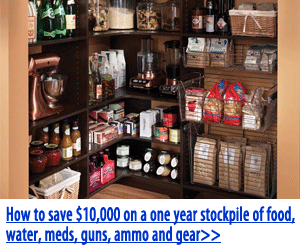- Introduction
- Choosing the Right Mylar Bags for Food Storage
- Proper Techniques for Storing Food in Mylar Bags
- Long-Term Food Preservation Tips
- Frequently Asked Questions about Storing Food in Mylar Bags
- Conclusion
Introduction
Storing food in mylar bags has become an essential strategy for many prepping enthusiasts and survivalists aiming to preserve food efficiently. As we look toward 2025, understanding the best practices for storing food in mylar bags ensures your supplies remain fresh, safe, and ready for use when needed. Whether you’re stockpiling for emergencies or simply extending the shelf life of pantry items, mylar bags offer unparalleled protection against moisture, oxygen, and light.
Personally, I’ve seen how proper storage in mylar bags can dramatically keep food’s nutritional quality intact over years. The key lies in choosing the right materials and techniques to maximize their effectiveness. As food storage technology advances in 2025, mastering the art of storing food in mylar bags has never been more relevant for securing your food future.
Choosing the Right Mylar Bags for Food Storage
Types of Mylar Bags
When selecting mylar bags for storing food, it’s important to choose the right type based on your needs. There are standard and heavy-duty variants, with the latter offering superior durability for long-term storage. Heavy-duty mylar bags are less prone to punctures and tears, making them ideal for keeping stored food safe over many years.
For everyday storage, standard mylar bags may suffice, especially if you plan to store food for a shorter time. Additionally, look for bags that come with a reliable heat-sealable strip, which is essential for creating an airtight seal. Proper selection ensures your stored food remains protected and uncontaminated in the long run.
Size Considerations
Choosing the correct size of mylar bags is crucial for efficient storage and ease of handling. Smaller bags are perfect for storing spices, herbs, or portion-controlled items, while larger bags can accommodate grains, beans, or freeze-dried foods. Proper sizing helps minimize empty space and reduces risk of spoilage due to excess air.
In 2025, smart storage solutions include using appropriately-sized bags to optimize space and maintain freshness. Remember to consider the quantity of food you plan to store and choose a size that allows for a tight, secure seal to prevent oxygen infiltration. The right size makes all the difference in successful food preservation.
Food Compatibility
Not all mylar bags are created equal when it comes to storing certain types of food. For example, oily foods like nuts and seeds may require additional barriers to prevent degradation. Ensure that your mylar bags are food-grade and suitable for the specific foods you’re storing.
In 2025, selecting bags with compatibility for specific food types is vital for maintaining quality. Some bags come with added barriers or are coated to better protect sensitive foods. Always check manufacturer specifications to ensure you’re choosing the best bag for your storage needs.
Cost and Quality Balance
While it might be tempting to opt for cheaper options, investing in high-quality mylar bags pays off in the long run. Superior bags are less likely to puncture or degrade, which is critical for long-term storage. Remember, the goal is to protect your food for years, so quality should never be compromised.
In 2025, balancing cost and quality involves researching reputable brands and reading reviews from other users. Sometimes paying a little extra upfront saves you money by preventing spoilage or the need for re-storage. Choose wisely to ensure your food stays fresh and safe.
Proper Techniques for Storing Food in Mylar Bags
Preparing the Food
Before sealing your food in a mylar bag, proper preparation is essential. Ensure foods are completely dry and free from moisture, which can cause mold or spoilage. If necessary, dehydrate or freeze foods beforehand to maximize their shelf life.
Labeling your food items with the date and contents helps in keeping track of storage times. Using oxygen absorbers during this step further enhances preservation by removing residual oxygen, crucial for storing food in mylar bags successfully.
Sealing Methods
Effective sealing is key to preventing air and moisture from compromising stored food. Use a high-quality heat sealer designed for mylar bags to create a secure, airtight seal. Make sure to run the sealer along the entire top edge for a uniform seal.
For best results, double-check the seal before storing. In 2025, advanced sealers with adjustable temperature controls help achieve better results, ensuring your storing food in mylar bags remains airtight for years to come.
Inserting Oxygen Absorbers
Oxygen absorbers are a game-changer for long-term food storage. They actively remove oxygen from inside the bag, slowing down spoilage and preventing insect infestation. For most dried foods, 300-400 cc absorbers are recommended.
Insert the oxygen absorber immediately after packing the food and just before sealing the bag. This small step significantly extends shelf life and maintains quality, making your storing food in mylar bags more effective and reliable.
Storage Environment
Proper storage conditions are just as important as sealing. Keep your mylar-packed foods in a cool, dry, and dark place to prevent deterioration. Temperatures above 75°F can accelerate spoilage, so consider climate considerations in your storage area.
In 2025, innovative storage solutions include using climate-controlled environments or insulated containers to protect your stored food. Consistent environmental control maximizes the benefits of storing food in mylar bags, ensuring longevity and quality.
Get Whole Wheat Flour, Grains and Milling Supplies – CLICK HERE
Long-Term Food Preservation Tips
Rotating Your Food Stockpile
Even with excellent storage methods like storing food in mylar bags, it’s wise to rotate your supplies regularly. Use older items first and replenish stocks with fresh food to maintain freshness. This practice prevents items from expiring unnoticed.
Implementing a rotation schedule helps you identify potential issues early, ensuring your food storage remains reliable. This approach is especially useful in 2025 as new storage technologies can be integrated into your system for optimal results.
Using Desiccants and Oxygen Scavengers
DESICCANTS help absorb excess moisture inside your storage bags, providing an extra layer of protection against humidity. When combined with oxygen scavengers, they create an optimal environment for long-term food preservation.
In 2025, combining these products with properly sealed mylar bags can extend the shelf life of stored foods to 10 years or more. This extra precaution gives peace of mind knowing your food remains safe and viable over extended periods.
Regular Inspection
Periodic checks on your stored food help catch issues like leaks, punctures, or moisture buildup early. This proactive approach prevents spoilage and preserves your investment in food storage.
Make a habit of inspecting your stored foods every 6 to 12 months. In 2025, using technology like moisture meters or thermal cameras can help monitor storage conditions more effectively.
Adding Fresh Supplies
Maintaining a stock of fresh food is essential for a resilient storage system. When you add new supplies, take the opportunity to update labels and reorganize your stacks for easy access.
Storing food in mylar bags isn’t just about long-term preservation; it’s also about creating a sustainable system. Regularly updating your supplies ensures your preparedness remains robust in 2025 and beyond.
Frequently Asked Questions about Storing Food in Mylar Bags
What is the best way to store food in mylar bags for long-term preservation?
The best way to store food in mylar bags for long-term use involves selecting high-quality bags, thoroughly drying the food, adding oxygen absorbers, and sealing the bags with a reliable heat sealer. Placing the sealed bags in a cool, dark, and dry environment maximizes shelf life. Regularly inspecting your storage area and rotating supplies further enhances preservation.
Can I store oily or greasy foods in mylar bags?
Yes, but extra precautions are recommended. Oily foods can degrade the bag material over time, potentially compromising its integrity. It’s advisable to use mylar bags with additional barrier coatings designed for oily foods and to include moisture and oxygen-absorbing materials.
Properly sealing and monitoring these types of foods are essential to prevent spoilage and preserve quality over years of storage.
How long can food be stored in mylar bags before it spoils?
With optimal techniques, storing food in mylar bags can extend shelf life up to 10-25 years, depending on the food type and storage conditions. Dried grains, beans, and freeze-dried foods tend to last the longest when stored properly.
Environmental factors like temperature, humidity, and light significantly influence preservation. Regular maintenance and choosing the right bags help achieve maximum longevity in your food storage plan for 2025.
What are some common mistakes to avoid when storing food in mylar bags?
Avoid overfilling bags, which can prevent proper sealing and oxygen removal. Failing to add oxygen absorbers or using low-quality bags also risks spoilage. Additionally, storing bags in hot, humid, or direct sunlight environments accelerates deterioration.
Ensuring proper preparation, sealing, and environmental control are vital steps in successful storing food in mylar bags. Staying vigilant prevents common pitfalls and prolongs your food’s freshness.
Conclusion
Storing food in mylar bags remains one of the most effective methods for securing your food supply well into 2025 and beyond. By selecting the right bags, employing proper sealing techniques, and maintaining ideal storage conditions, you can significantly extend the shelf life of your stored foods. Embracing these expert tips not only safeguards your nutritional investments but also provides peace of mind for any emergency or long-term food storage plan. Remember, the key to successful storing food in mylar bags is consistency and attention to detail, ensuring your food remains fresh, safe, and ready whenever you need it.
Find out more information about “storing food in mylar bags”
Search for more resources and information:
Related Content
- The Ultimate Guide to 10 Effective Safe Long Term Storage of Wheat Berries in 2025
- Storing Grains at Home: A Health Perspective
- The Ultimate Guide to Safely Storing Grains for Long Term in 2025 Secrets
- The Ultimate Guide to Grain Storage for Long Shelf Life in 2025: 7 Effective Strategies to Preserve Your Harvest
- Grain Storage and Preservation Without Electricity
Auto Amazon Links: No products found.







